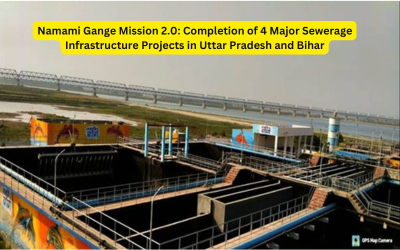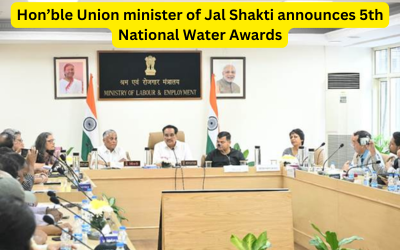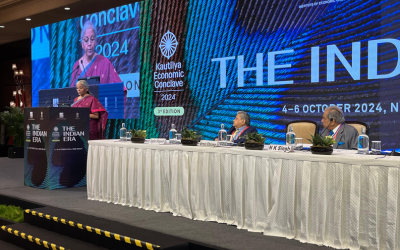Table of Contents
ToggleNamami Gange Mission 2.0: Boost to Clean Ganga with New Sewerage Projects in UP and Bihar
Under the Namami Gange Mission 2.0, the Ministry of Jal Shakti successfully completed four significant projects in the second quarter of the financial year 2024-25. These initiatives, located in Uttar Pradesh and Bihar, aim to prevent sewage from entering the river, enhance water quality, and rejuvenate the rivers. This effort is crucial for maintaining the sanctity of the Ganga and its tributaries.
Developed at a total cost of Rs 492 crore, these projects (under Namami Gange Mission 2.0) focus on improving wastewater treatment across various regions. In Patna-Danapur, Bihar, a 25 MLD Sewage Treatment Plant (STP) and an Interception & Diversion (I&D) network were completed at a cost of Rs 103 crore. Similarly, in Patna-Maner, Bihar, an STP with a capacity of 6.5 MLD and an I&D network were completed at a cost of Rs 70 crore.
In Kairana, Uttar Pradesh, a 15 MLD STP along with an I&D network was completed at a total cost of Rs 78 crore. This project (under Namami Gange Mission 2.0), located on the Yamuna River, follows the Design, Build, Operate, and Transfer (DBOT) model. Additionally, in Lucknow, Uttar Pradesh, a major project to rejuvenate the Gomti River led to the successful completion of a 39 MLD STP at a total cost of Rs 241 crore.
An agreement has been signed for the development of a project in Saharanpur, Uttar Pradesh, approved under Namami Gange mission -II with financial assistance from the World Bank. A tripartite agreement was signed for the conservation of the Hindon River’s tributaries—Pawandhoi and Dhamola—in Saharanpur. This agreement involves the NMCG, Uttar Pradesh Jal Nigam (Rural), and M/s EIEL Infra Engineers (Saharanpur) Pvt Ltd (a consortium of M/s Enviro Infra Engineers Ltd, M/s Bhugan Infracon Pvt Ltd, and M/s Micro Transmission Systems SPV).
This project includes the construction of a 135 MLD STP, sewage pumping stations, and interception structures, with a total cost of Rs 344 crore. It will operate on a Hybrid Annuity PPP Model and includes a 15-year O&M provision.
Environmental Projects
Aimed at promoting sustainability and conservation. Here are a few notable ones:
Creating Oxygen Hubs by Cummins India Ltd.: This project focuses on converting non-forest land into forest areas to combat pollution in Pune, Maharashtra. Over 35,000 trees have been planted as part of this initiative.
Save Bird Campaign by DB Corp Ltd.: This campaign aims to conserve bird species by encouraging citizens to keep bird baths filled with food grains and water. It has seen significant participation across multiple states including Madhya Pradesh, Gujarat, and Rajasthan.
Sustainable Design Projects: India is also making strides in sustainable design with projects that incorporate green building practices. These projects aim to reduce environmental impact through innovative architectural solutions.
These initiatives reflect India’s commitment to environmental sustainability and conservation. Are there any specific types of projects or regions you’re particularly interested in?
Under the Namami Gange Mission 2.0, we're taking strides to restore the lifeline of India – our rivers! In the second quarter of FY 2024-25, four key projects in Uttar Pradesh and Bihar have been completed to prevent sewage from entering the Ganga and its tributaries.
— Namami Gange (@cleanganganmcg) October 17, 2024
✅… pic.twitter.com/D4TJOHGG9f
Renewable Energy Projects
India has been actively investing in renewable energy projects to meet its growing energy demands sustainably. Here are some notable projects:
National Solar Mission: Launched in 2010, this mission aims to establish India as a global leader in solar energy. The goal is to achieve 100 GW of solar power capacity by 2022.
Wind Energy Projects: India ranks 4th globally in wind power capacity. The country has several large wind farms, including the Muppandal Wind Farm in Tamil Nadu and the Jaisalmer Wind Park in Rajasthan.
National Green Hydrogen Mission: This initiative aims to produce 5 million metric tonnes of green hydrogen annually by 2030. It focuses on using renewable energy sources to produce hydrogen, which can be used in various industries.
Solar Parks and Ultra-Mega Solar Power Projects: The government has set a target to establish 40,000 MW of solar power capacity through these projects. They are designed to provide large-scale solar power generation.
Waste to Energy Projects: These projects aim to convert municipal solid waste into energy. They help in managing waste and generating renewable energy simultaneously.



